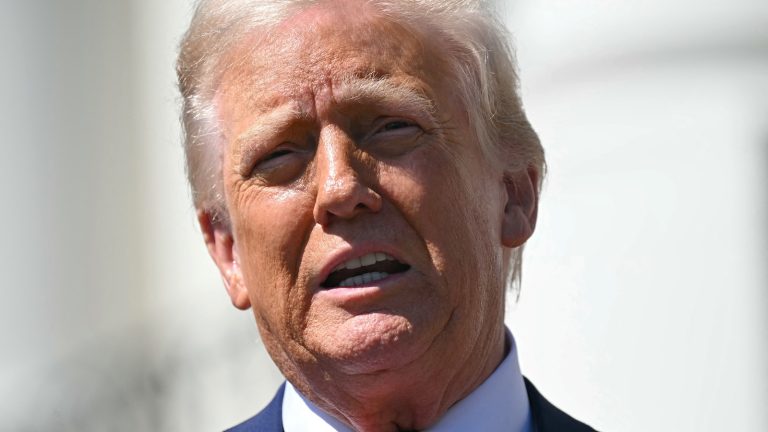Shortly after President Donald Trump on Wednesday suddenly backtracked on his destabilizing “reciprocal” tariffs, instituting a 90-day pause for most affected nations except China, reporters asked him what led him to the change in course.
“I thought that people were jumping a little bit out of line. They were getting yippy. You know, they were getting a little bit yippy, a little bit afraid,” Trump said during a photo op with racing champions outside the White House.
It’s unclear what exactly he was referring to, but he signaled he had been keeping an eye on the wildly volatile markets, including a selloff in the bond market where he said “people were getting a little queasy.”
“Over the last few days it looked pretty glum,” he said, before quickly turning to tout the stock uptick immediately after his announcement of the 90-day pause — something he first communicated in a social media post that rocked the markets and the world.

President Donald Trump speaks during an event with the racing champions from NASCAR Cup Series, NTT IndyCar Series, and IMSA WeatherTech SportsCar Championship, at the White House in Washington, April 9, 2025.
Saul Loeb/AFP via Getty Images
“You have to be flexible,” Trump explained, despite repeatedly insisting his tariffs were here to stay. “You have to be able to show a little flexibility. And I’m able to do that.”
Later, in the Oval Office, Trump said the pause was something he’d been thinking about over a period of time that “came together this morning.”
“And we decided to pull the trigger, and we did it today, and we’re happy about it,” Trump said.
It was a marked shift from his bluster earlier this week. Trump told ABC News Chief White House Correspondent Mary Bruce on Monday he was “not looking” at a pause.
On Tuesday night, hours before the elevated tariffs took effect, his defiant message for Republican lawmakers was: “I know what the hell I’m doing.”
White House officials spun Trump’s abrupt reversal as courageous and even part of an overall grand negotiation strategy, even though the administration had been sending mixed messages on whether bargaining was even on the table.
“It took great courage, great courage for him to stay the course until this moment and what we have ended up with here,” said Treasury Secretary Scott Bessent.

President Donald Trump prepares to sign an executive order in the Oval Office of the White House, April 9, 2025 in Washington.
Saul Loeb/AFP via Getty Images
“President Trump created maximum negotiating leverage for himself, and the tariffs went into effect 15 hours ago, the ones that we have lowered … were announced a week ago, and we’ve just been overwhelmed, overwhelmed by the response from mostly our allies, who want to come and negotiate in good faith,” Bessent said.
White House press secretary Karoline Leavitt told the media, “Clearly you missed the art of the deal” — a not subtle reference to Trump’s 1987 book.
“We finally have a president here at the White House who is playing the long game, who is doing what is right for the American worker in our industries here at home,” Leavitt contended.
While markets surged after Trump’s pause announcement, uncertainty continues over what happens next.
Bessent said Trump wants to be “personally involved” in the negotiations with other nations, and that “it is going to take some time.” Trump said he wants to make “fair deals.”

White House press secretary Karoline Leavitt and Treasury Secretary Scott Bessent speak to reporters outside the West Wing of the White House, April 9, 2025, in Washington.
Nathan Howard/Reuters
Looming large is the China factor as the U.S. and Beijing — the world’s two largest economies — escalate tariffs.
As part of the pause, the White House said for countries who want to negotiate, the baseline tariff level for all countries will be lowered to 10%. For China, however, Tump’s tariff is being increased to a whopping 125% after Beijing issued retaliatory taxes against U.S. goods.
Trump said on Wednesday he was “honored” to have done the tariffs, arguing no other president would have done it.
“Nothing’s over yet, but we have a tremendous amount of spirit from other countries, including China,” Trump said. “China wants to make a deal. They just don’t know how quite to go about it.”
Trump’s “Liberation Day” unveiling of high tariff rates for dozens of trade partners marked an achievement Trump’s chased for decades.
But in the days that followed, markets slumped and trillions of dollars were lost in retirement and college savings accounts. Republicans and business leaders started to openly express mounting anxiety about the president’s sweeping approach, some of which Trump said he’d watched on cable news shows.
Senate and House Republicans expressed relief after Trump’s change of heart.
“A lot of smiles,” said Sen. Mike Rounds.



